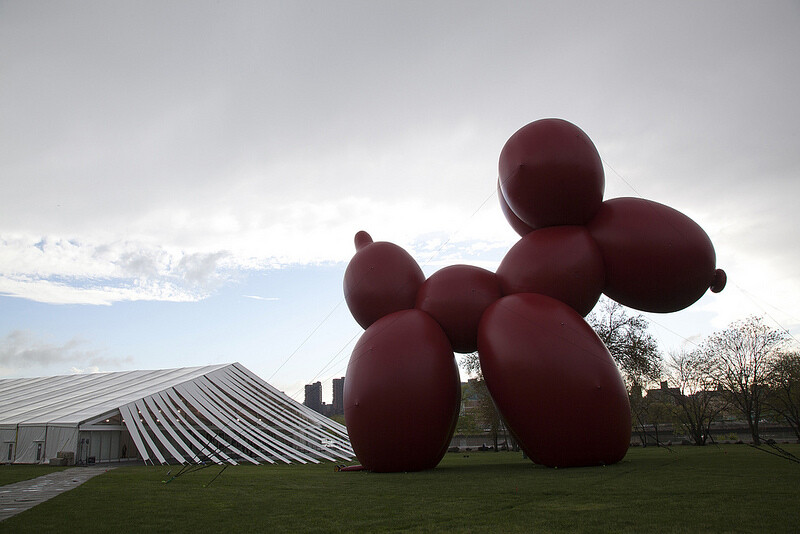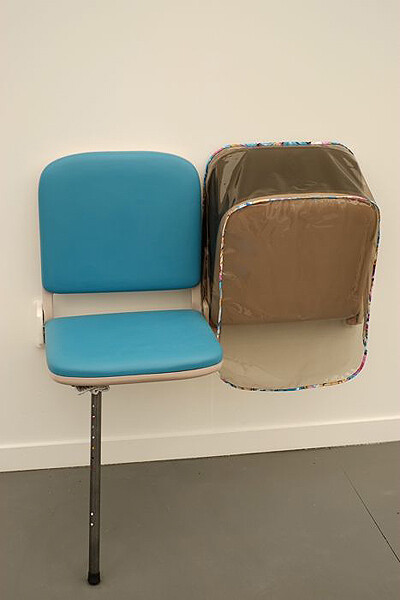“Contemporary art: one, us: zero,” quipped a friend as we mistakenly toured what appeared to be the off-limits back room of Marian Goodman’s booth at Frieze New York. We were looking for Tino Sehgal’s performance Ann Lee. Aware of the nature of Sehgal’s work probing social boundaries through real life situations, my partner and I weren’t entirely convinced our foray into Goodman’s secret room wasn’t part of the performance itself. Our mishap was worthwhile though: it brought us to Ann Lee, an adolescent girl performing a monologue as a fictional Manga character originally developed by Pierre Huyghe and Philippe Parreno in 1999. The duo had purchased the rights to the character from a Japanese animation company, and subsequently invited other artists, such as Dominique Gonzalez-Foerster, Rirkrit Tiravanija, and Liam Gillick, to include her in their work. Originally a vacant character, she is figuratively filled by the artist’s intention. Sehgal’s version of Ann Lee comprises a rotating cast of confident, “robotic” 11-year-old girls, replete with mechanical limb movements, who directly engage audience members with questions like “Would you rather be too busy or not busy enough?” (Unsurprisingly, most audience members preferred to be too busy.) The piece examines a collective desire to be filled or occupied—with distraction, personal fulfillment, or what have you—and in turn, a fear of stagnation and vacancy. That “Ann Lee” focuses on the art fair goer seems an exceedingly apropos subject for the opening day of Frieze, which was mottled with well-shorn, busybody alpha patrons.
Though its performative nature and challenging salability is undoubtedly anomalous, Sehgal’s performance epitomizes the high quality of work at Frieze New York’s sophomore edition. The fair’s serpentine SO – IL-designed tent boasts twenty more booths than last year’s effort, reaching to 180 galleries in total. And while the titanic amount of galleries proves it impossible to adequately see the entire fair in one day (I was there a total of six hours and can only hope I caught a glimpse, at least, of everything), the overall tone of Frieze New York’s opening day was posh, bright, contemporary, and poised in addition to the usual bourgeois art fair goings-on, and the presence of decidedly cool, emerging artists penetrated the fair.
Most satisfying were booths resuscitating vintage chromogenic prints from decades past. Elizabeth Dee showed a photographic pairing by the lesser-known British photographer Mac Adams. The first photograph depicts a man seemingly wiring a bouquet of daffodils to spy on an unsuspecting woman, the second showing the subject at home amidst the arrangement, perhaps being unwittingly recorded. Titled Conversation [Diptych], the 1975 piece compresses crime narrative into highly staged mise en scène, a rare potential historical analog to the increasingly celebrated, idiosyncratic young conceptual artist Alejandro Cesarco. (With Murray Guy, Cesarco’s installation-cum-detective story The Streets Were Dark with Something More Than Night or the Closer I Get to the End the More I Rewrite the Beginning won the Baloise Art Prize at Art Basel in 2011.) For Frieze New York, Murray Guy presented Zoe Leonard’s vintage chromogenic prints, most of which were taken during her forays to remote Alaska in the mid-90s. The striking images—ranging from depictions of a dismembered bear and moose to a dead beaver laid prone in his watery grave—build upon feminist investigations into the gaze endemic to the 1980s, positioning the human being as predator and consumer. At Reena Spaulings, Ken Okiishi’s breathtakingly honest (but unsent) 1997 postcards addressed to art world luminaries such as Larry Clark or Jack Pierson track his coming-of-age lust for a straight friend—a gay rendering of the universal experience of potent desire, rejection, and consequent alienation.
The relative lack of work made before the 1970s was assuaged by a few unique, hard-hitting presentations from artists with decades-old careers. Gagosian showcased a work from Robert Rauschenberg’s lesser-known series of Gluts, metal assemblage sculptures made primarily in the late-eighties while the artist was visiting an economically depressed Texas. Paris’s Galerie Chantal Crousel showed an unusual vitrine-bound but characteristically explosive Thomas Hirschhorn, while B. Wurtz’s grocery-themed paper collages puzzled and dazzled at Richard Telles Fine Art.
The fair ushered in an exciting bevy of young London imports relatively unexposed in New York. London’s The approach brought Magali Reus’s strangely poetic custom-made stadium seats propped up by a crutch leg, meditating on notions of public support, as well as Alice Channer’s hybrid-state, droopy resin clothing. Carlos/Ishikawa, also of London, presented a solo showing by Steve Bishop one could likely smell before they see. In addition to a cutting of the gallery’s wall repositioned as a temporary structure delineating the booth, Bishop’s Listerine tray hilariously and noxiously permeates the fair—a new take on “cutting through fair bullshit.” Shoreditch’s Limoncello presented an Ikea kitchen-inspired installation replete with ceramics by Jesse Wine, who is perhaps on top of the never-ending surge in contemporary art pottery. David Raymond Conroy’s work at Seventeen wraps paravents in fabric (more commonly associated with African clothing), and juxtaposes them with photographic collages meditating on the functionality and history of photography.
London’s contemporaries across the pond presented equally successful, materially inventive work by young Americans. Gavin Kenyon’s bulbous yet phallic, fuzzy plaster works impart a dark take on relatively traditional sculpture at Lower East Side’s Ramiken Crucible. Fellow LES gallery 47 Canal shows the similarly inventive Stuart Uoo, who is the subject of a current two-person exhibition with Jana Euler at the Whitney Museum of American Art (Euler’s winsome paintings can be seen in the fair at Brussels gallery dépendance’s booth). Uoo’s work at 47 Canal comprises a set of busts representing, in a degraded, post-human fashion, each of the famed four females of “Sex and the City.” The mannequins, burnt, are fashioned with floppy hats, bandanas, and tutus, and tout wires for veins. Nearby hang a selection of exceedingly tacky yet expensive designer fabrics that help position Uoo’s busts as belonging to a private, post-identity fantasy world in which a gay (or straight, for that matter) man is just as likely to identify with Carrie Bradshaw as any undergrad co-ed.
If there’s anything surprising about Frieze New York’s second year, it’s perhaps the seamlessness of its presentation. Is the fair’s continued success too good to be true, especially given the long history of the Armory’s struggle for relevance? While the fair’s private usage of public, tax-supported New York property and the company’s refusal to hire unionized workers has precipitated heated New York City Council meetings (1), these issues have yet to turn many heads in the art world. No one wants to rain on the Frieze parade, presumably because New York has yearned so long for a hip, commercially viable fair. It could be argued that Frieze (and not entirely unlike this publication) is built on a highly commercial yet alternative, self-sustaining funding system. This well-oiled machine accrues cultural capital from Frieze’s exceptionally edited magazine, which in turn creates an attractive brand, fueling the pay-to-play desire to show in the fair. While this structure isn’t especially pernicious, it explicitly represents a new model of power: just to be rich or cool isn’t enough to claim your place at the front of the rat race. Today, you have to be both.
1) http://teamsternation.blogspot.com/2013/05/new-york-city-council-hearing-slams.html













